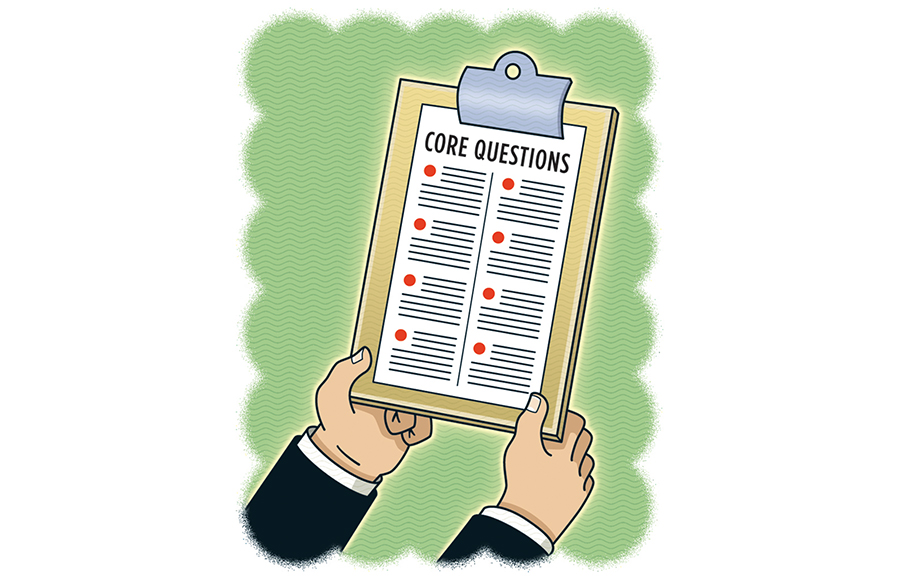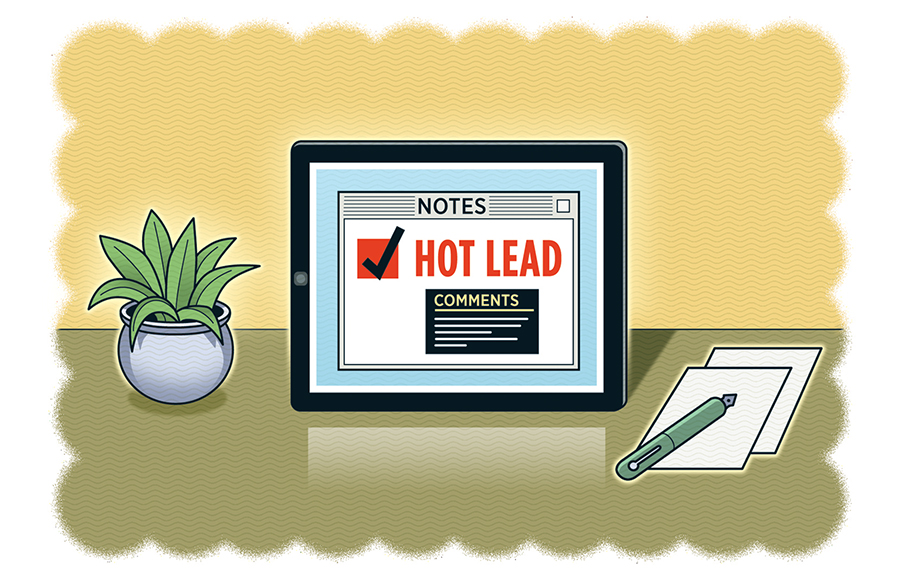|
lead qualifying
 Five Steps to
Lead-Qualifying Success Develop and administer effective lead-qualifying questions with these five easy steps. By Linda Armstrong
You can't tell a primo prospect from a giveaway glutton without a killer lead-qualification system. And especially when lead quantity and quality are often the chief means to measure the value of your exhibit-marketing program, typical qualifying questions – those involving budget, authority, needs, and timeline, aka BANT – are just the beginning. You also need to gather sales-department input, craft carefully conceived answer alternatives, and elicit excellent execution. In effect, you need a fine-tuned Q&A process if you hope to separate the wheat from the chaff.
To help you create such a system, EXHIBITOR sought advice from four industry experts who've been there and qualified that. While their tactics vary, they agree that in most cases face-to-face, staffer-to-attendee qualification is the way to go, as opposed to tech-based self-qualification. Thus, they've offered the following five-step guide to developing effective staffer-led lead-qualifying questions. 1. Develop Core Questions Your first step is to flesh out your queries. And while BANT or its more modern cousin CHAMP – which stands for challenges, authority, money, and prioritization – are good starts, they won't necessarily result in actionable leads. Or more to the point, if your lead-qualification conversations don't deliver information that meets your internal salespeople's needs, reps may not follow up no matter how meticulously you've constructed your queries. "Lead questions should be developed with the needs of your sales department top of mind," says Holly Sherrill, president of Marketech360, a provider of measurement-driven program solutions and booth-staff training in Birmingham, AL. "If you don't ask the right questions and thus deliver the appropriate information to your sales department, reps are far less likely – or perhaps even unable– to follow up on those leads." In effect, if you skip this step, all of your carefully culled leads could go to waste, and your exhibit-marketing efforts could be for naught. To identify these critical objectives, Ken Mortara, CEO of ShowValue Inc., an event-measurement company in Tucson, AZ, suggests that you go straight to the source. "Select a handful of key sales reps from your company and ask them the following question: 'When you meet someone who could be a prospect or customer, what questions do you ask to determine if he or she is qualified for further follow-up?' Listen carefully to both the queries and the order in which salespeople feel they should be asked. Then, based on this feedback, make an initial prioritized list of potential core questions." Next, sources recommend that you analyze the questions to see if any BANT or CHAMP components are absent. If so, query salespeople to make sure they've intentionally bypassed these mainstays before you omit them from your list entirely. 2. Scrutinize and Prioritize With a handful of potential core questions under consideration, your next step is to assess past performance, tweak queries to improve effectiveness, and narrow your list to five or six. Gwen Hill, CTSM, senior vice president of business development at Exhibit Force, a Houston-based technology firm that provides cloud-based business- and event-management software, recommends that you first analyze the effectiveness of previous lead-qualifying questions. For example, did staffers routinely skip one or more of the questions? Did their thoroughness wane the further they progressed through the queries? Are there key questions that you've overlooked in your current set of potential inquiries?
Current Client Queries
"Try to get a feel for what worked and what didn't," Hill says. "Then circle back to past booth staffers and ask them for their feedback on the questions and the overall experience. You'll likely gain valuable insight that can then be used to improve your questions and the entire lead-qualifying process."
Traditional lead-qualifying questions often don't take into consideration the unique needs of current clients. As such, you may want to consider developing a separate lead form for booth visitors already doing business with your company. Here's a list of potential queries specifically geared to gather valuable information from existing clientele. ➤ Thank you for your previous purchase. How well is our product currently performing for you? ➤ What challenges has it failed to solve, or what new challenges have you experienced? ➤ Since you initially purchased our product (or service), has anything changed within your firm with regard to mergers, acquisitions, division focus, etc.? If so, what? ➤ In what ways have your personal job-related challenges and responsibilities evolved in the last year (six months, two years, etc.)? ➤ Has anything changed with regard to your role in purchasing, and how would you describe that role? ➤ Are you currently looking to purchase an upgrade or complete replacement, or are you searching for a totally different type of solution? ➤ Is your company's budget for this new project similar in scope to that of your previous purchase? ➤ If you're looking for an upgrade, what do you wish our product (or service) would offer that your current version does not? ➤ What were some of the factors that originally influenced your decision to purchase from us? ➤ If you could change one thing about our current product (or service), what might that be? Based on this historical analysis, you should have a decent list of potential question for your lead form. But now you likely need to cull the herd. Mortara recommends that you go back to your sales team to hone this handful of inquiries to five or six at most. "There are exceptions to the rule," he says, "but most attendees aren't willing to work through more than five or six core questions, whether you're using a tablet-based qualifying process or a conversational one. Ask too many questions, and attendees tune out or walk out." So stick to five or six inquiries, but always include a notes section at the bottom of the form where staff or attendees can input important information that falls outside the norm. Mortara also suggests you include a "hot lead" checkbox in the notes section. "Even the best qualifying questions can miss a hot lead," he says. "For example, let's say a young attendee approaches your booth, and he doesn't have a solid understanding of his own needs or budget parameters, nor can he field your questions about future desires and current challenges. So in terms of lead quality, he's a hard-core F. However, during an in-booth conversation, he reveals that his dad is the CEO of a company your salespeople have been courting for years. In effect, then, this is your golden ticket, an A-squared lead if you will. But there's no way to reflect this info on the standard lead form." To handle situations like these – and others where a staffer has a gut feeling that this attendee is going to switch to A status in the very near future – Mortara advocates for a simple checkbox for "hot" leads. Staffers can then note why this otherwise "cool" prospect is a scorcher. 3. Test and Recalibrate After identifying five or six key queries, it's time to bring in the big guns – i.e., existing clients – to test question effectiveness. One testing method is to simply talk to former booth visitors about their experiences. "Try to find clients who experienced the qualification process recently and then ask them what they remember about that experience, how it made them feel, and which questions got them talking – or turned them off. Then adapt your qualifying questions accordingly," Hill says. For example, perhaps your client remembers that he or she felt a little put off by your generic "So what brings you to the show today?" opener, but he or she felt more receptive to a comparably lighthearted and personal "What is your role at ABC company, and what kind of technology pain points have been sticking you in the ribs this year?" conversation starter. Another test method is to role-play booth interactions with existing clients. This will provide insight on how your queries might be woven into a conversation, help you determine if the order is effective, and allow you to analyze how the nature of the question affects the person being queried. You could do this role-play over the phone, but Skype or a similar online-meeting service will better simulate a face-to-face booth interaction. 
Cull your lead-qualification questions to five or six killer queries, which is the maximum number most attendees will answer without bailing.
As you role-play the qualifying process, watch for nonverbal client cues as to how each query makes him or her withdraw or engage. Also consider how well the questions work into the conversation and whether the staffer might be uncomfortable asking them – or whether altering the question or order might better facilitate the natural flow of the conversation.After the exercise, pepper the client with questions, such as how the experience made him or her feel, whether the order of questions was appropriate, and even whether the tone seemed on par with the audience. Also ask if any information was left on the table, so to speak. That is, did the questions prompt the client to reveal key needs or upcoming purchases for which your product or service might be suitable, or did he or she refrain from revealing this info based on the narrow parameters of the question being asked? Your analysis may reveal that your queries are spot on, or you may discover questions you've completely overlooked. Or, perhaps a lighter tone or slower process is more appropriate for your target market. "The point here is to take attendees' needs and preferences into consideration as you scrutinize your list of potential questions," Hill says. Along these same lines, always consider the preferences of existing customers. Sources advise that most exhibitors should have some type of special plan in place for these VIPs. That is, for current customers, typical lead-qualification questions can be everything from mildly awkward to downright insulting, as they may expect you to already be familiar with their firm. So ensure that you, your staff, and your salespeople have created an amended or perhaps completely separate qualifying conversation for clients. 
Even the most carefully crafted lead-qualifying questions can miss a prime prospect. Experts recommend including a "hot lead" checkbox in the notes section of your lead form to ensure nontraditional – but valuable – booth visitors aren't overlooked.
For example, instead of doing a deep dive into a customer's buying power and plans to purchase, you might discuss any changes that have recently taken place within his or her company (e.g., mergers, strategy changes, management directives, new products, etc.), any new pain points (e.g., smaller budget, fewer staffers, new services), or even an upgrade to current products and services. Plus, consider ushering customers to a hospitality area, offering them a giveaway immediately, or handing them off to a specific salesperson or account executive. The solution will vary by company, but the point is to establish a special experience – and perhaps a few unique questions – for these people who have already made an investment in your firm.4. Fine-Tune Answers With a carefully calibrated set of questions, it's time to consider the available answers. Because according to Mortara, offering multiple-choice questions, as opposed to open-ended, is best. Some lead-qualification processes are completed by attendees with the aid of a tablet or lead-card form, and in these situations, effective multiple-choice answer options are critical. However, multiple-choice answers should also be used when staffers lead the qualification process. "Most effective lead questions offer attendees a choice of answers, as opposed to allowing staffers to input custom text," Mortara says. That's because multiple-choice answers cut down on the time required to complete a lead form and allow you to highlight product benefits in the answers. That is, as you read the possible answer options to attendees, you can subtly promote your product or service. For instance, Hill suggests taking a calculated approach to positioning your products as superior to your competitors – or embedding your key messages into the discussion – via carefully crafted multiple-choice answers. "Consider the benefits of your product or service, particularly as it compares to the competition," she says. "Then strategically phrase your questions and answers to highlight benefits your product or service offers that the competition lacks." Case in point: Perhaps your product is 20 percent more energy efficient than those of your top competitors. You might ask attendees a needs/challenges question such as "Which of the following benefits is the most important to you?" Staff would then read the answers to attendees (or they would read them individually if you're using a self-guided lead-qualifying process). One of the answers, then, might include a specific benefit your product offers, such as: The benefit that's most important to me is a 20-percent increase in efficiency. "You don't want the answers to be cheesy or forced, but try to work your product benefits into them, which then gives staffers an easy segue into a features discussion," Hill says. In addition to a list of standard multiple-choice answers, always include an "other" option, ideally with a field with ample space in which to elaborate on the custom response. "Without this safety valve, so to speak, staffers are sometimes forced to select an answer that's not necessarily true for the attendee just to continue forward progress," Mortara says. "This is called a type-one error or a false positive, as it asserts something is true even when it's not." Mortara also strongly recommends using ranges as much as possible, as attendees usually don't know specifics. For example, if you ask when they intend to make a purchase, they may not have a specific date in mind, but they can venture a good guess. So range-based answers – e.g., within a week, in the next two to six months, next year, etc. – allow you to hone in on the information you need. 
Since attendees' short-term memory is limited, experts suggest offering a maximum of seven possible responses to multiple-choice lead-qualifying questions.
In terms of the number of possible responses, Mortara cautions that less is more. "Miller's Law [devised by cognitive psychologist George Miller] generally asserts that the average human brain can only retain seven pieces of information in short-term memory," he says. "As such, it's best to keep answers to seven options or less. Faced with too many options to remember or read through again and again, attendees tend to pick any answer they can remember – or one that comes close to the truth – in an effort to speed the process."5. Execute Effectively Once most exhibit managers have assembled a handful of killer questions and appropriate multiple-choice answers, they pack their bags and head for the show. However, to make your lead-qualification process truly effective, you must also consider the "how" part of the equation. That is, how will your staffers administer the questions and obtain the answers? No matter what form of delivery and collection system you choose – be it paper forms, tablets, apps, etc. – unless your intent is to have myriad attendees fill in a lead form without ever talking to a staffer, the interaction between staff and attendees is paramount. "Trade shows are all about face-to-face interaction," says Matt Hill, president of The Hill Group, a staff-training firm in Cupertino, CA. "So the goal is to have real, authentic conversations with attendees, as opposed to forced – not to mention awkward – qualification-driven exchanges while hurriedly collecting someone's lead information." One way to foster this natural conversational tone is to allow for free-form, as opposed to tightly scripted, wording. "Make sure staffers are very familiar with all of the questions, and encourage them to put them into their own words," says Matt Hill. "Then help them role-play various scenarios to assist in carefully working the key qualifiers into normal conversation." The point here isn't to tweak the questions via role-playing but rather to smooth out the delivery for your staff. Mortara also suggests you use a two-step qualification system, even in smaller booths. "We typically use a booth ambassador to greet the attendee and do initial qualification. Based on the person's answers, he or she is then handed off to an appropriate subject-matter expert, directed to a demo or activity of some sort, or politely persuaded to disengage." This type of initial engagement puts any bit of uncomfortable awkwardness up front and allows the subject-matter expert to finesse the experience after the initial handoff. Also ensure that your booth staff understands how to transition to "step two" once the qualification process is complete. "Whether that means redirecting an attendee to a colleague with specific expertise, an activity, a demo, a hospitality area, or even the aisle, staffers need to understand how to segue from the qualification process into the next logical step," says Matt Hill. "If you train people how to open a lead-qualifying process but never how to close it, they'll waste valuable time when they should have disengaged and interacted with a new potential lead." So from start to finish, effective lead qualifying is more than just freestyling an in-booth conversation with attendees and taking a few notes for the sales team back at the home office. Rather, you need to develop the right questions, the proper answers, and a well-trained and -rehearsed exhibit staff to execute an effective lead-qualifying experience. E
Lead By Examples
Five to six lead-form questions will produce essential baseline data for your sales team. But what if the conversation naturally keeps rolling beyond basic qualification? What kind of follow-up questions will help staffers bulk up the notes section of the lead form? Here, Matt Hill, president of the staff-training firm The Hill Group, offers several examples. Needs and Challenges ➤ How do you think our products and services could help you? ➤ What challenges or problems is your business going through? ➤ How long have you been putting up with this problem? What made you decide to solve this now? ➤ What has prevented you from solving it in the past? ➤ If you've made a purchase of this type before, how did it work out for you? ➤ What specific hurdles might stop you from reaching your goals, and how are you planning to address them? ➤ What would happen if you can't solve this problem? Purchase Authority ➤ What is your decision-making process, and what role do you and other stakeholders play in it? ➤ How does the budget sign-off process work? ➤ What potential concerns do you think other stakeholders will have? What would be the best way to handle them? Timing and Prioritization ➤ How soon would you like a solution in place? ➤ How important is this solution to you right now? Where does this stack up in terms of priority and urgency? ➤ What else is a priority? ➤ When do you foresee having the resources to implement this plan? Budget and Competition Assessment ➤ Has this project been funded? ➤ What kind of budget have you allocated for this project? ➤ What does that budget include? ➤ What other solutions are you considering? ➤ Where do we stack up in terms of functionality and pricing when compared to these other solutions that are on the table? Follow-up and Closing ➤ I think we have more to discuss. When would be a good time to schedule a call or meeting? ➤ Based on what you've heard so far, how good of a fit do you think our firm is for what you're looking to accomplish? ➤ Ideally, what would be the focus of our next meeting? ➤ What would be the best way to get to you everything that you need, such as customer references, so you'll feel comfortable making a decision?
|
|
|
||||||||||||||||||||||||||||
|
|
||||||||||||||||||||||||||||
|
TOPICS Measurement & Budgeting Planning & Execution Marketing & Promotion Events & Venues Personal & Career Exhibits & Experiences International Exhibiting Resources for Rookies Research & Resources |
MAGAZINE Subscribe Today! Renew Subscription Update Address Digital Downloads Newsletters Advertise |
FIND-IT Exhibit & Display Producers Products & Services Supplier to Supplier All Companies Compare Get Listed |
EXHIBITORLIVE Sessions Certification Exhibit Hall Exhibit at the Show Registration |
ETRAK Sessions Certification F.A.Q. Registration |
EDUCATION WEEK Overview Sessions Hotel Registration |
CERTIFICATION The Program Steps to Certification Faculty and Staff Enroll in CTSM Submit Quiz Answers My CTSM |
AWARDS Sizzle Awards Exhibit Design Awards Portable/Modular Awards Corporate Event Awards Centers of Excellence |
NEWS Associations/Press Awards Company News International New Products People Shows & Events Venues & Destinations EXHIBITOR News |
||||||||||||||||||||
|
||||||||||||||||||||||||||||






